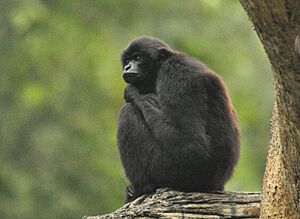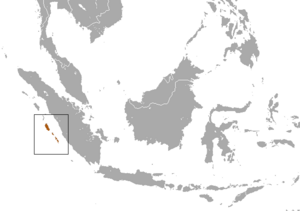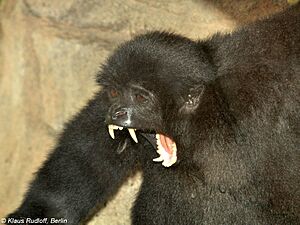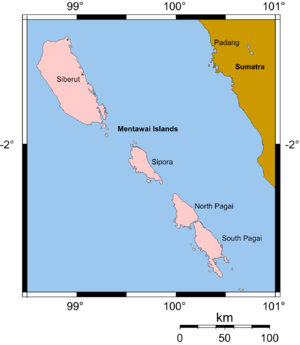Kloss's gibbon facts for kids
Quick facts for kids Kloss's gibbon |
|
|---|---|
 |
|
| Conservation status | |
| Scientific classification | |
| Genus: |
Hylobates
|
| Species: |
klossii
|
 |
|
| Kloss's gibbon range | |
The Kloss's gibbon (Hylobates klossii) is also known as the Mentawai gibbon, the bilou, or the dwarf siamang. It is an endangered primate from the gibbon family.
This gibbon is easy to spot because it is completely black. It looks a bit like a siamang but is much smaller. Kloss's gibbons are about 17 to 25 inches (44 to 63 cm) tall. They weigh up to 13 pounds (6 kg). Like all gibbons, they have very long arms and no tail. It's hard to tell male and female Kloss's gibbons apart.
Contents
Where Kloss's Gibbons Live
Kloss's gibbons live only on the Mentawai Islands. These islands are west of Sumatra in Indonesia. The Mentawai Islands are a group of four main islands. They are rich in different kinds of plants and animals. Many endemic species live here, meaning they are found nowhere else.
Kloss's gibbons are active during the day. They live in the rain forest canopy, high up in the trees. They use their long arms to swing through the branches. They rarely come down to the ground. These gibbons use tree limbs to cross things like rivers.
Like other gibbons, they live in pairs. Each pair claims a territory of about 49 to 74 acres (20 to 30 hectares). They protect this area fiercely from other gibbons.
How Kloss's Gibbons Communicate
Kloss's gibbons are special because males and females do not sing together. Male Kloss's gibbons sing before the sun comes up. Female Kloss's gibbons sing after the sun has risen.
Female Kloss's gibbon calls are unique. They change slightly during different parts of the song. These calls might tell other gibbons where they are in the trees.
Kloss's Gibbon Life Cycle
The way Kloss's gibbons reproduce is like other gibbons. A female gibbon usually gives birth to one baby every two to three years. Her pregnancy lasts about seven months.
The baby gibbon drinks its mother's milk until it is about 18 months old. It becomes fully grown around seven years of age. In the wild, they can live for about 25 years. In zoos, they can live up to 40 years.
Kloss's gibbons are monogamous, meaning they have one partner for life. Male gibbons use their territory to attract a mate. They defend their territory with loud calls and threats. During courtship, both the male and female defend their territory together. Mating happens only after the female thinks the male can protect a good home.
What Kloss's Gibbons Eat
Kloss's gibbons are picky eaters. They never eat fruit that is too ripe. Their diet includes fruit, leaves, new shoots, and insects.
Figs are a favorite fruit for Kloss's gibbons. However, they don't spend much time eating figs. This is because figs are hard to find on the Mentawai Islands. They also eat other plant parts, bird eggs, and small animals.
Kloss's Gibbon Behavior
When human researchers watch Kloss's gibbons, the gibbons get used to them. This is called habituation. Once habituated, they won't run away when observed.
Gibbons that are not used to humans sometimes act as a decoy. One male gibbon will make warning calls to get attention. This allows the rest of his group to escape safely.
Kloss's gibbons behave in ways that help them stay hidden. This helps them avoid hunters. Female gibbons sing less often than males. Males only sing before dawn when it's hard to see. Kloss's gibbons also spend less time grooming or playing together. This might help them stay hidden from hunters.
Protecting Kloss's Gibbons
Kloss's gibbons are in danger of disappearing forever. The IUCN Red List says they are an endangered animal (as of 2021). Scientists believe there are only about 20,000 to 25,000 Kloss's gibbons left in the wild. Their numbers are still going down. Over the last 25 years, their population has dropped by half.
Kloss's gibbons have no natural enemies. Humans are the biggest threat to them. Local people on the Mentawai Islands hunt Kloss's gibbons for food. They also hunt them illegally.
Changes like new roads and industries on the islands are destroying the gibbons' home. Better hunting tools, like air rifles, make it easier for people to hunt them.
Kloss's gibbons spend most of their time in the tree canopy. This means they need healthy, old-growth forests to survive. Their island homes are losing forests due to deforestation.
Conservationists are working to protect Kloss's gibbons. They want to save and connect the forests where these gibbons live. This allows the gibbons to move safely without being exposed. Local governments are working with groups like UNESCO. They are raising awareness and protecting more land on the Mentawai Islands.




